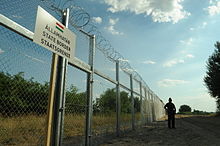European Union response to the 2015 migrant crisis
In it they proposed distributing refugees from Syria, Eritrea and Iraq across EU states based on their GDP and population.,[1] with the possibility to opt out of hosting and instead contribute money for resettlement.
Eastern countries such as Slovakia, Hungary, Romania and the Czech Republic declared their intention to defy the decision and refused to accept any refugees at all.
[16] The Czech echoed this negative sentiment when the Secretary for European Affairs Tomáš Prouza commented that relocated people would eventually leave regardless [citation needed].
[26] The UK government cited fears that the operation was "an unintended 'pull factor', encouraging more migrants to attempt the dangerous sea crossing and contributing to drownings.
[29][30] On 18 May 2015, the European Union launched a new operation based in Rome, named EU Navfor Med, under the command of the Italian Admiral Enrico Credendino,[31] to identify, capture and dispose of vessels used by migrant smugglers.
Some Italian authorities feared that rather than saving lives, the NGO operations encouraged more people to use the dangerous passage facilitated by human traffickers.
[35] The Human Rights Watch and Amnesty International criticised the code of conduct and some NGOs, including Doctors Without Borders, eventually suspended rescue operations.
A study conducted from 2014 to 2019 concluded that external factors like weather and the political stability of Libya contributed more to the ebbs and flows of migrants crossing the Mediterranean.
[37] After 700 migrants drowned following a shipwreck in the Mediterranean Sea on April 19,[38] EU leaders called for an emergency meeting of European interior ministers.
Aydan Özoğuz, the German minister for immigration, refugees, and integration, said that emergency rescue missions in the Mediterranean should recommence as more migrants were likely to arrive as the weather turned warmer.
[41] A previously scheduled routine meeting of EU foreign ministers the day after the shipwreck was dominated by refugee policy and preventing migrant deaths.
[42] The same day, the European Commission published a ten-point plan to address deaths in the Mediterranean Sea, which doubled the size and budget of Operation Triton and called for capturing or destroying smuggler boats.
Around November 2015, some European countries restricted family reunions for refugees, and started campaigns to dissuade people worldwide to migrate to Europe.
[50][51] Opponents, most notably German chancellor Angela Merkel, argued that limiting the numbers of refugees would undermine the principle of asylum, contravene national or international laws[52] and be physically unworkable.
[61] In 2015 and following years, many governments also began formally designating certain countries "safe" in order to make it easier to deny asylum applications from and deport people from them.
[67] In late December 2015, Slovenia erected a razor-wire fence along the Istria and Gorski Kotar sections of its border with Croatia, to block migrants and refugees heading for more northern parts of Europe.
The WWF and locals warned that the fence would threaten endangered species that roam across the area, such as lynx and brown bears, which are protected by law in Croatia.
[70][71] Some observers considered the supposed risk of increased immigration a pretext for centralising executive power, since migrant numbers had already receded significantly by this point.
[91] On November 13, 2015, a group of men consisting of both EU citizens and non-citizens detonated suicide bombs at a football stadium, fired on crowded cafes and took hostage a concert hall of 1500 people.
[98] In 2016, the Italian daily newspaper La Stampa reported that officials from Europol conducted an investigation into the trafficking of fake documents for ISIL.
They identified fake Syrian passports in the refugee camps in Greece meant for supposed members of ISIL to avoid Greek security and make their way to other parts of Europe.
These reports ranged from adult Islamic State sympathisers celebrating terror attacks to violent children dressing up as IS fighters to decapitate teddy bears.
[100][101] In February 2017, British newspaper The Guardian reported that ISIL was paying smugglers fees of up to $2,000 USD to recruit people from refugee camps in Jordan in a desperate attempt to radicalize children for the group.
"[103] In October, a plot by neo-Nazis to attack a refugee center with explosives, knives, a baseball bat, and a gun was foiled by German police.
Because of the lack of water, medical care and security protection witnessed by the Euro- Med monitor team- especially with the arrival of winter, they were at risk of serious health deterioration.
In addition, migrants were subject to regular xenophobic attacks, fascist violence, forced strip searches at the hands of residents and police, and detention.
Women living in the Athens settlements and the Vasilika, Softex and Diavata camps felt worried about their children as they may be subjected to sexual abuse, trafficking and drug use.
[105] In November 2016, German security officials cracked down on a militant salafist organisation calling itself Die Wahre Religion, which had been targeting newly arrived refugees.
Other organisations include Transitions, a social enterprise that provides advice and helps refugees find placements depending on their qualifications and skills.
[117] In some countries that took in large numbers of asylum seekers, this has resulted in people not having legal residency rights, raising worries of institutionalised poverty and the creation of parallel societies.


